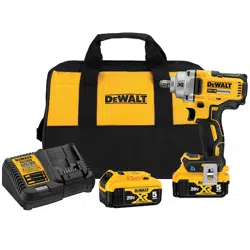Loading ...
Loading ...
Loading ...

ENGLISH
8
select the best speed for a particular application. The more
you squeeze the trigger, the faster the tool will operate. For
maximum tool life, use variable speed only for starting holes
orfasteners.
NOTE: Continuous use in variable speed range is not
recommended. It may damage the switch and should
beavoided.
Forward/Reverse Control Button (Fig. A)
A forward/reverse control button
2
determines the
direction of the tool and also serves as a lock-offbutton.
To select forward rotation, release the trigger switch and
depress the forward/reverse control button on the right side
of thetool.
To select reverse, release the trigger switch and depress the
forward/reverse control button on the left side of thetool.
The center position of the control button locks the tool in
the off position. When changing the position of the control
button, be sure the trigger isreleased.
NOTE: The first time the tool is run after changing the
direction of rotation, you may hear a click on start up. This is
normal and does not indicate aproblem.
Worklight (Fig. A)
There is a worklight
7
located on the foot of the tool. The
worklight is activated when the trigger switch is depressed,
and will automatically turn off 20 seconds after the trigger
switch is released. If the trigger switch remains depressed,
the worklight will remain on. The light's timeout can be
adjusted or the light disabled in ToolConnect™.
NOTE: The worklight is for lighting the immediate work
surface and is not intended to be used as aflashlight.
ASSEMBLY AND ADJUSTMENTS
WARNING: To reduce the risk of serious personal
injury, turn unit off and remove the battery pack
before making any adjustments or removing/
installing attachments or accessories. An
accidental start-up can causeinjury.
Tool Connect™ Mode Selector (Fig. D)
WARNING: To reduce the risk of injury, remove
accessories from the tool chuck before using the
modeselector.
The DCF896 and DCF896H are equipped with a mode
selector that allows Modes 1, 2, and 3 to be customized
using the Tool Connect™ app (refer to Table 1). Once
configured, pressing the mode selector button
8
on the
foot of the tool will cycle through the modes
13
. The Home
Mode settings are not customizable and the Home Mode is
active when the home indicator
12
is lit.
If you are unsure of the current configuration, press the
mode selector button
8
to set the tool to the Home Mode
(home indicator
12
is lit).
8
Fig. D
12 13
Precision Wrench™ (Fig. D)
In addition to normal impacting modes, this tool features
the Precision Wrench™ mode which grants the user greater
control in both fastening and loosening applications.
When set in forward, the tool will fasten at 2000 RPM until
impact begins. The tool will pause for a duration set by
the user in Tool Connect™ before continuing to impact
at a rate of 3100IPM, providing the user with greater
control and reducing the chance of overtightening or
damagingmaterial.
When set in reverse, the tool will impact at a normal speed
and rate of 3100 IPM. Upon sensing that the fastener has
broken free, the tool will cease to impact and will reduce
speed to help prevent “run-off” of loose hardware. Speed
reduction can be set by the user in ToolConnect™.
Impact Time
Tool will automatically shut off after impacting for a specific
time limit set by the user in the Tool Connect™app.
Precision Tap™
CAUTION: Use only impact-rated taps
andaccessories.
CAUTION: Tapping not recommended for use on
critical or precisionworkpieces.
CAUTION: Tap life is heavily affected by tool
alignment with the workpiece, speed settings,
material condition andlubrication.
CAUTION: Tap breakage may occur if tap is driven
too far without clearing chips. Choose tapping speed
and time settings that do not overload the tap by
driving it too far beforereversing.
CAUTION: Use caution not to drive a tap past the end
of its threads, or to bottom a tap in a blindhole.
CAUTION: Always follow tap manufacturer’s
guidelines for proper tap selection and use with
different materials, cutting fluids, tap drill sizes and
feedrates.
CAUTION: Precision Tap™ mode is not recommended
for use with taps less than 5/16" (8mm) or more than
3/4" (20 mm) indiameter.
CAUTION: Recommended tapping speeds in Tables
2 and 3 are a suggestion only, based on test results
tapping new threads at 75% thread depth. It is
recommended to perform a test application on scrap
material, starting at speed 1 and working up. Tapping
Loading ...
Loading ...
Loading ...
